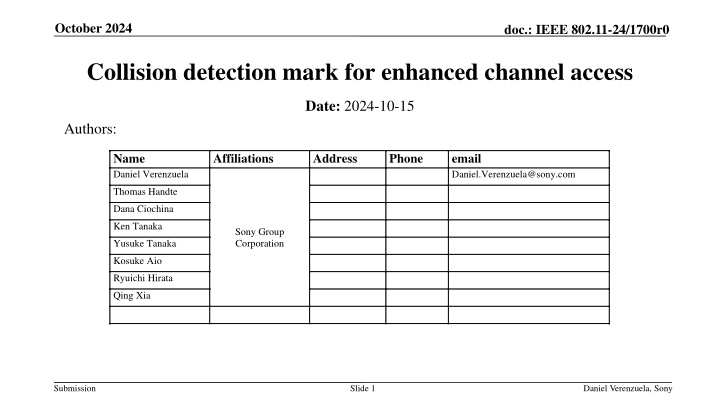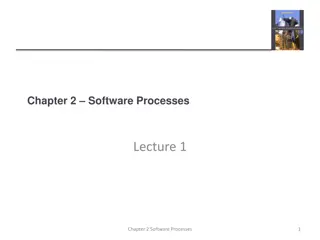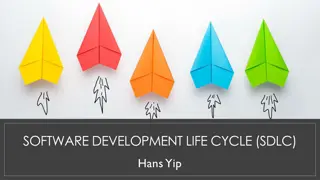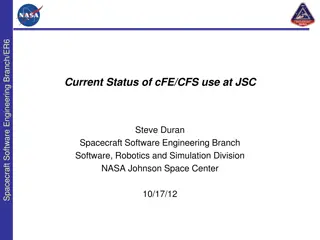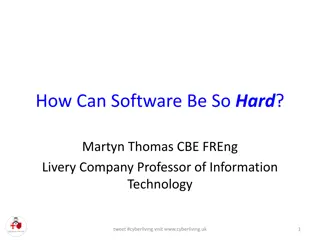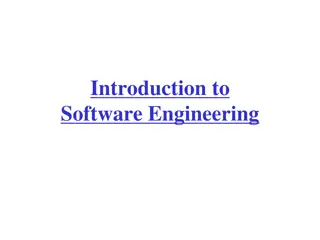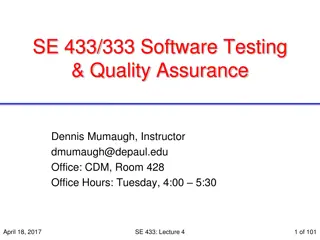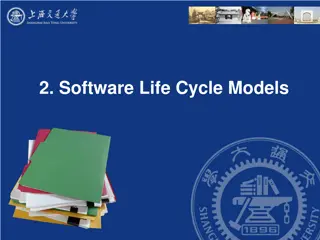Test Driven Development in Software Projects
Test Driven Development (TDD) is a crucial software development practice that emphasizes creating unit test cases before writing actual code. TDD involves three phases: creating precise tests, correcting the code, and refactoring to optimize. Frameworks for TDD cater to various programming languages. TDD seamlessly fits into Agile development by providing constant feedback and aligning with changing project requirements. The advantages of TDD include better program design, higher code quality, detailed project documentation, and reduced project development time
Download Presentation

Please find below an Image/Link to download the presentation.
The content on the website is provided AS IS for your information and personal use only. It may not be sold, licensed, or shared on other websites without obtaining consent from the author.If you encounter any issues during the download, it is possible that the publisher has removed the file from their server.
You are allowed to download the files provided on this website for personal or commercial use, subject to the condition that they are used lawfully. All files are the property of their respective owners.
The content on the website is provided AS IS for your information and personal use only. It may not be sold, licensed, or shared on other websites without obtaining consent from the author.
E N D
Presentation Transcript
October 2024 doc.: IEEE 802.11-24/1700r0 Collision detection mark for enhanced channel access Date: 2024-10-15 Authors: Name Daniel Verenzuela Affiliations Address Phone email Daniel.Verenzuela@sony.com Thomas Handte Dana Ciochina Ken Tanaka Sony Group Corporation Yusuke Tanaka Kosuke Aio Ryuichi Hirata Qing Xia Submission Slide 1 Daniel Verenzuela, Sony
October 2024 doc.: IEEE 802.11-24/1700r0 Introduction 11bn aims at reducing 95th percentile of latency which is largely caused by channel access delay Several channel access enhancements have been proposed for 11bn Collision avoidance enhancements (CW optimization [1], short contention phase [2]) Short signal for channel access request (during contention [3], overlapped with PPDU [4]) Defer signal to enable high priority contention [5-7] ELR PPDU format has been proposed for 11bn ELR mark can facilitate robust packet detection and BSS identification [8-9] Proposal: Collision resolution mechanism for low UL channel access delay Non-AP STA includes an PHY collision detection mark (CD mark) in preamble AP sends collision response granting access to least 1 colliding STA Slide 2 Submission Daniel Verenzuela, Sony
October 2024 doc.: IEEE 802.11-24/1700r0 Issue of channel access delay Collisions Collisions result in exponential increase of channel access delay A collision leads to lost airtime when intended receiver cannot decode frames The colliding STAs increase CW to reduce collision probability resulting in additional delay Exponential delay Increase CW Lost airtime Additional channel access delay STA 1 Additional channel access delay STA 2 AP BAck BAck BAck BAck BAck BAck x2 2xCW -1 CW Timeout STA 1 PPDU Busy PPDU PPDU Busy x2 AIFS 2xCW -1 CW PPDU Timeout STA 2 PPDU Busy Busy Busy AIFS AIFS AIFS Collision STA 3 Busy PPDU PPDU Busy PPDU PPDU EIFS AIFS Submission Slide 3 Daniel Verenzuela, Sony
October 2024 doc.: IEEE 802.11-24/1700r0 Proposal for fast collision resolution 1. Non-AP STAs include a collision detection mark (CD mark) in preamble CD mark facilitates detection and identification of the transmitting non-AP STA 2. AP detects CD mark and sends collision response (CR) Indicates that a collision occurred and at least one non-AP STA with granted channel access Resolves the collision and avoids the exponential backoff for other non-AP STAs Additional channel access delay STA 2 Lost airtime AP CR BAck BAck BAck BAck BAck BAck STA 1 mark CD PPDU PPDU PPDU Busy Busy x1 CW CW STA 2 mark mark CD CD PPDU Busy PPDU Busy PPDU AIFS Collision STA 3 mark CD Busy Busy Busy PPDU PPDU AIFS AIFS Submission Slide 4 Daniel Verenzuela, Sony
October 2024 doc.: IEEE 802.11-24/1700r0 CD mark design as legacy modulated field (1/2) Non-HT PPDU format: L-STF L-LTF L-SIG CD mark NonHT-Data ELR PPDU format: RL- SIG ELR- STF U-SIG ELR-LTF ELR-SIG L-STF L-LTF L-SIG ELR-CD mark ELR-Data ELR PPDU format can also be used for enhanced collision detection Can define an ELR-CD mark to support collision detection ELR-CD mark would identify BSS (or BSS color) and transmitting STA Submission Slide 5 Daniel Verenzuela, Sony
October 2024 doc.: IEEE 802.11-24/1700r0 CD mark design as legacy modulated field (2/2) CD mark signal Aim to design signals with low cross-correlation between STAs Consider that colliding PPDUs are not synchronized Use legacy 48 data tones and assign a group of tones to each STA Modulate tones with BPSK or QBPSK sequence Each contending STA should be uniquely identifiable BSS identification can be part of sequence Example: Create 8 groups of 6 tones each (can identify 8 STAs) Assume several CD mark length options 4us : 1 symbol 3.2 us + CP of 0.8 us 8us : 2 symbols 6.4 us + CP of 1.6 us Subcarriers Guard STA 1 STA 2 STA 3 STA 4 DC STA 5 STA 6 STA 7 CD mark STA 8 Guard CP Sym 1 Sym N CD mark symbol Submission Slide 6 Daniel Verenzuela, Sony
October 2024 doc.: IEEE 802.11-24/1700r0 PPDU with CD mark enables identification of at least one colliding STA Simulation set up Colliding PPDUs Format: Non-HT carrying RTS (20MHz) CD mark inserted after L-SIG in all PPDUs Impairments Time offset: Uniform dist. [0 9us] CFO: Uniform dist. [0 200Hz] SNR = 5dB, CD mark Len = 4us SNR = 5dB, CD mark Len = 8us SNR = 25dB, CD mark Len = 4us Probability of identifying at least one CD mark is comparable to L-STF packet detection SNR = 25dB, CD mark Len = 8us Submission Slide 7 Daniel Verenzuela, Sony
October 2024 doc.: IEEE 802.11-24/1700r0 PPDU with CD mark enables identification of at least one colliding STA with legacy STA collision CD mark Len = 4us Simulation of collision between two PPDUs Two PPDUs carrying RTS (20MHz) One legacy PPDU (No CD mark included) Fixed TX power (to achieve 5 dB SNR at RX) One PPDU including CD mark Varying TX power Independent impairments on both PPDUs Time offset: Uniform dist. [0 9us] CFO: Uniform dist. [0 200Hz] Receiver synchronizes and decodes without prior knowledge Always checks if CD mark if present after L-SIG One CD mark miss detection vs L-SIG decoding error 6 to 10 dB SINR gain around 0.15 error rate 60% to 70% lower error floor 6dB ~60% Random TO_1 L-LTF L-STF L-SIG Data Random TO_2 L-LTF L-STF L-SIG CD mark Data CD mark Len = 8us 10dB ~70% Submission Slide 8 Daniel Verenzuela, Sony
October 2024 doc.: IEEE 802.11-24/1700r0 Convergence of channel access enhancements for 11bn Key approaches proposed for channel access enhancements Short contention phase [2] Short signal for channel access request [3] Defer signal to enable high priority contention [5-7] Potential way forward CD mark can be an enabler for previous proposals on enhanced channel access Can support robust STA and BSS identification Can be used before or during a short contention phase Acts as a short channel access request with basic backward compatibility Can act as a defer signal Submission Slide 9 Daniel Verenzuela, Sony
October 2024 doc.: IEEE 802.11-24/1700r0 Conclusion Channel access enhancements are important for improving latency in 11bn A collision detection mark in PPDU preamble can enable collision resolution with high reliability 95% probability of AP identifying at least one colliding STA 6 to 10 dB SINR gain compared to L-SIG decoding when colliding with legacy STAs AP can send a collision response to avoid exponential channel access delay Propose to define a PPDU format for enhanced channel access Include a CD mark to identify transmitting STA within a collision Submission Slide 10 Daniel Verenzuela, Sony
October 2024 doc.: IEEE 802.11-24/1700r0 References [1] 11-24/0772r1 CSMA collision analysis [2] 11-24/0773r1 CSMA with enhanced collision avoidance [3] 11-24/1183r1 Low latency low collision low power medium access continued [4] 11-24/0811r1 Overlapped indication for aperiodic low latency traffic [5] 11-24/0840r0 hip EDCA proposal [6] 11-24/0467r1 hip EDCA follow up legacy impact [7] 11-24/1193r0 EDCA for high priority access [8] 11-24/1478r2 ELR PPDU design [9] 11-24/1571r1 Extended Long Range (ELR) Mark Symbol Design Submission Slide 11 Daniel Verenzuela, Sony
